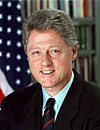Related Research Articles

The 1996 Republican National Convention convened at the San Diego Convention Center (SDCC) in San Diego, California, from August 12 to August 15, 1996. The convention nominated former Senator Bob Dole from Kansas, for president and former Representative and secretary of Housing and Urban Development Jack Kemp, from suburban Buffalo, New York, for vice president.
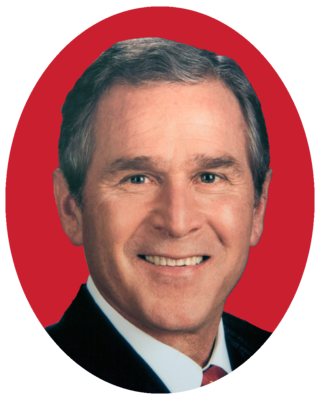
The 2000 Republican National Convention convened at the First Union Center in Philadelphia, Pennsylvania, from July 31 to August 3, 2000. The 2,066 delegates assembled at the convention nominated Texas Governor George W. Bush for president and former U.S. Secretary of Defense Richard B. "Dick" Cheney for vice president.
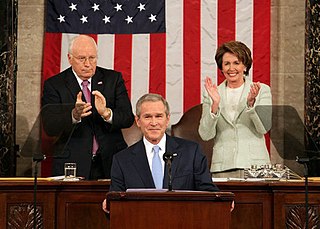
The 2007 State of the Union Address was given by the 43rd president of the United States, George W. Bush, on January 23, 2007, at 9:00 p.m. EST, in the chamber of the United States House of Representatives to the 110th United States Congress. It was Bush's sixth State of the Union Address and his seventh speech to a joint session of the United States Congress. Presiding over this joint session was the House speaker, Nancy Pelosi, accompanied by Dick Cheney, the vice president, in his capacity as the president of the Senate.

The 2008 State of the Union Address was given by the 43rd president of the United States, George W. Bush, on January 28, 2008, at 9:00 p.m. EST, in the chamber of the United States House of Representatives to the 110th United States Congress. It was Bush's seventh and final State of the Union Address and his eighth and final speech to a joint session of the United States Congress. Presiding over this joint session was the House speaker, Nancy Pelosi, accompanied by Dick Cheney, the vice president, in his capacity as the president of the Senate.

The 2000 State of the Union Address was given by the 42nd president of the United States, Bill Clinton, on January 27, 2000, at 9:00 p.m. EST, in the chamber of the United States House of Representatives to the 106th United States Congress. It was Clinton's seventh and final State of the Union Address and his eighth and final speech to a joint session of the United States Congress. Presiding over this joint session was the House speaker, Dennis Hastert, accompanied by Al Gore, the vice president, in his capacity as the president of the Senate.

Barack Obama, the 44th president of the United States, addressed a joint session of the United States Congress on Tuesday, February 24, 2009. It was his first public address before a joint session. Similar to a State of the Union Address, it was delivered before the 111th United States Congress in the Chamber of the United States House of Representatives in the United States Capitol. Presiding over this joint session was the Speaker of the United States House of Representatives, Nancy Pelosi, accompanied by Joe Biden, the vice president in his capacity as the president of the Senate.

The 1997 State of the Union Address was given by the 42nd president of the United States, Bill Clinton, on February 4, 1997, at 9:00 p.m. EST, in the chamber of the United States House of Representatives to the 105th United States Congress. It was Clinton's fourth State of the Union Address and his fifth speech to a joint session of the United States Congress. Presiding over this joint session was the House speaker, Newt Gingrich, accompanied by Al Gore, the vice president, in his capacity as the president of the Senate.

The 1999 State of the Union Address was given by the 42nd president of the United States, Bill Clinton, on January 19, 1999, at 9:00 p.m. EST, in the chamber of the United States House of Representatives to the 106th United States Congress. It was Clinton's sixth State of the Union Address and his seventh speech to a joint session of the United States Congress. Presiding over this joint session was the House speaker, Dennis Hastert, accompanied by Al Gore, the vice president, in his capacity as the president of the Senate.
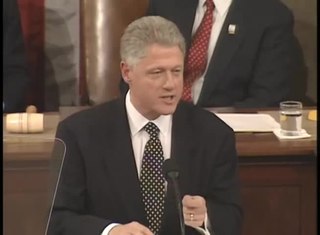
The 1998 State of the Union Address was given by the 42nd president of the United States, Bill Clinton, on January 27, 1998, at 9:00 p.m. EST, in the chamber of the United States House of Representatives to the 105th United States Congress. It was Clinton's fifth State of the Union Address and his sixth speech to a joint session of the United States Congress. Presiding over this joint session was the House speaker, Newt Gingrich, accompanied by Al Gore, the vice president, in his capacity as the president of the Senate.
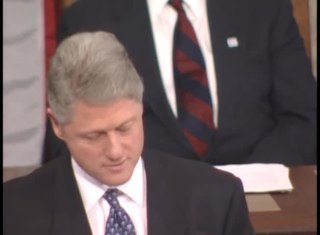
The 1995 State of the Union Address was given by the 42nd president of the United States, Bill Clinton, on January 24, 1995, at 9:00 p.m. EST, in the chamber of the United States House of Representatives to the 104th United States Congress. It was Clinton's second State of the Union Address and his third speech to a joint session of the United States Congress. Presiding over this joint session was the House speaker, Newt Gingrich, accompanied by Al Gore, the vice president, in his capacity as the president of the Senate.

The 1994 State of the Union Address was given by the 42nd president of the United States, Bill Clinton, on January 25, 1994, at 9:00 p.m. EST, in the chamber of the United States House of Representatives to the 103rd United States Congress. It was Clinton's first State of the Union Address and his second speech to a joint session of the United States Congress. Presiding over this joint session was House speaker Tom Foley, accompanied by Vice President Al Gore, in his capacity as the president of the Senate.
The 1992 State of the Union Address was given by the 41st president of the United States, George H. W. Bush, on January 28, 1992, at 9:00 p.m. EST, in the chamber of the United States House of Representatives to the 102nd United States Congress. It was Bush's third and final State of the Union Address and his fourth and final speech to a joint session of the United States Congress. Presiding over this joint session was the House speaker, Tom Foley, accompanied by Dan Quayle, the vice president, in his capacity as the president of the Senate.

The 1988 State of the Union Address was given by the 40th president of the United States, Ronald Reagan, on January 25, 1988, at 9:00 p.m. EST, in the chamber of the United States House of Representatives to the 100th United States Congress. It was Reagan's seventh and final State of the Union Address and his eighth and final speech to a joint session of the United States Congress. Presiding over this joint session was the House speaker, Jim Wright, accompanied by George H. W. Bush, the vice president.

The 1985 State of the Union Address was given by the 40th president of the United States, Ronald Reagan, on February 6, 1985 — Reagan’s 74th birthday — at 9:00 p.m. EST, in the chamber of the United States House of Representatives to the 99th United States Congress. It was Reagan's fourth State of the Union Address and his fifth speech to a joint session of the United States Congress. Presiding over this joint session was the House speaker, Tip O'Neill, accompanied by George H. W. Bush, the vice president.

The 2011 State of the Union Address was given by the 44th president of the United States, Barack Obama, on January 25, 2011, at 9:00 p.m. EST, in the chamber of the United States House of Representatives to the 112th United States Congress. It was Obama's second State of the Union Address and his third speech to a joint session of the United States Congress. Presiding over this joint session was the House speaker, John Boehner, accompanied by Joe Biden, the vice president, in his capacity as the president of the Senate.
The 1996 United States federal budget is the United States federal budget to fund government operations for the fiscal year 1996, which was October 1995 – September 1996. This budget was the first to be submitted after the Republican Revolution in the 1994 midterm elections. Disagreements between Democratic President Bill Clinton and Republicans led by Speaker of the House Newt Gingrich resulted in the United States federal government shutdown of 1995 and 1996.

The 2014 State of the Union Address was given by the 44th president of the United States, Barack Obama, on January 28, 2014, at 9:00 p.m. EST, in the chamber of the United States House of Representatives to the 113th United States Congress. It was Obama's fifth State of the Union Address and his sixth speech to a joint session of the United States Congress. Presiding over this joint session was the House speaker, John Boehner, accompanied by Joe Biden, the vice president, in his capacity as the president of the Senate.
The following is a timeline of the presidency of Bill Clinton, from January 1, 1996, to December 31, 1996.
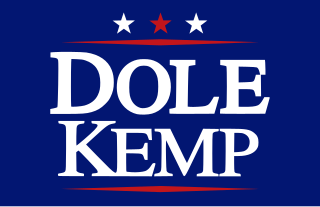
The 1996 presidential campaign of Bob Dole began when Republican Senator and Senate Majority Leader Bob Dole formally announced his candidacy for Republican Party nomination in 1995. After beating other candidates in the primaries, he became the Republican nominee, with his opponent being Democratic incumbent President Bill Clinton in the 1996 presidential election. Dole conceded defeat in the race in a telephone call to Clinton on November 5, 1996.

Bill Clinton, the 42nd president of the United States, addressed a joint session of the United States Congress on Wednesday, February 17, 1993. It was his first public address before a joint session. Similar to a State of the Union Address, it was delivered before the 103rd United States Congress in the Chamber of the United States House of Representatives in the United States Capitol. Presiding over this joint session was the Speaker of the United States House of Representatives, Tom Foley, accompanied by Al Gore, the vice president in his capacity as the president of the Senate.
References
- 1 2 Mitchell, Alison (January 24, 1996). "Clinton Offers Challenge To Nation, Declaring 'The Era of Big Government is Over'". The New York Times . Archived from the original on August 12, 2021. Retrieved December 23, 2011.
- ↑ "THE REPUBLICAN RESPONSE BY SENATE MAJORITY LEADER ROBERT DOLE". PBS . January 23, 1996. Archived from the original on November 12, 2012. Retrieved August 23, 2017.
- ↑ USA Today, Page A12. Feb 5, 1997
